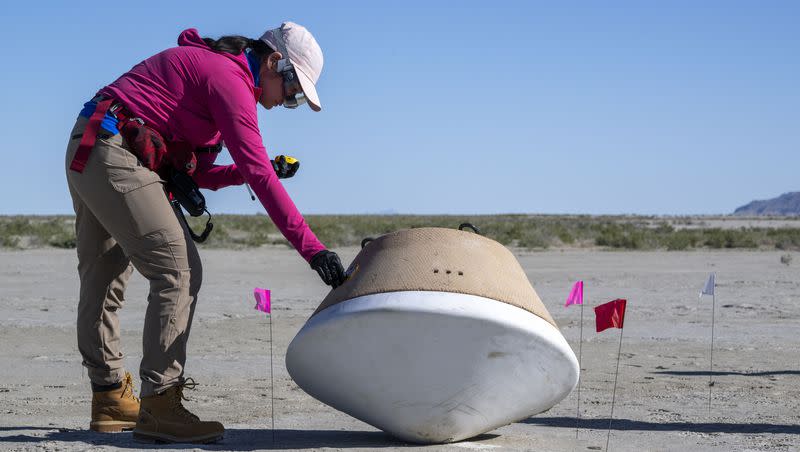How to watch Osiris-Rex return: Asteroid sample headed to Utah could shed new light on 4.5 billion-year-old mysteries

A $1 billion NASA mission that’s spanned seven years and amassed some 4 billion miles of space travel is due to send a small capsule screaming through Earth’s atmosphere at over 27,000 mph Sunday morning before a gentle parachute-assisted landing in Utah’s west desert, delivering a sample of precious material that weighs just a bit more than a cup of water.
But the dust and rubble captured by the Osiris-Rex mission from the Bennu asteroid, a top-shaped space rock that’s about one-third of a mile wide, isn’t just any random cosmic crud. The material that makes up Bennu is rich with carbon and possible organic compounds and are believed to be as old as the solar system itself. Scientists anticipate the sample will provide a wealth of new insight from the time the solar system was birthed, some 4.5 billion years ago.
The Osiris-Rex mission launched from Earth in 2016 on a journey that brought it to an orbit around Bennu in 2018. Bennu is a near-Earth asteroid, meaning it is on a path that orbits the sun. Bennu’s trek around the Sun takes 435 days but every six years the asteroid passes relatively close — within about 186,000 miles — to Earth. For reference, that’s closer to Terra Prime than the moon. Ahead of the opportunity to evaluate material from Bennu, scientists have a wealth of information gathered by Osiris-Rex over the two years it circled and observed the asteroid.
Related
High school students unveil new data on NASA’s earth-killer asteroid experiment
Earth strikes back: NASA successfully crashes spacecraft into asteroid in planetary defense test
NASA confirms that mission to change orbit of asteroid was a smashing success
NASA estimates the material sample will come in at just under 9 ounces. About 70% of the material will be saved for future study and the remainder will be shared among more than 200 researchers at 35 institutions around the world, including some at London’s Natural History Museum.
“OSIRIS-REx spent over two years studying asteroid Bennu, finding evidence for organics and minerals chemically altered by water,” wrote Ashley King, UKRI Future Leaders Fellow, Natural History Museum, in a web posting on Friday. “These are crucial ingredients for understanding the formation of planets like Earth, so we’re delighted to be among the first researchers to study samples returned from Bennu.”
One of the huge advantages of the Bennu sample, from a research perspective, is the material is “pristine” when compared to samples gathered from meteorites that have crashed to Earth and been contaminated by exposure to the planet’s atmosphere.
Osiris-Rex extended a vacuum tube to grab a material sample from Bennu in 2020, punching into the asteroid’s soft surface without actually landing on the space body, which is a loose amalgam of rocks, dust and debris held together by gravitational force.
Osiris-Rex left the Bennu asteroid in 2021 and will be wrapping up its two-year, four-month journey back to Earth on Sunday. While the craft will release the capsule containing the material sample from a distance of about 63,000 miles early Sunday morning, Osiris-Rex will continue its asteroid exploration mission, heading next to another near-Earth asteroid called Apophis, which it will reach in 2029.
NASA reports the Osiris-Rex return capsule, which measures about 3 feet wide and 11⁄2-feet tall, will enter the Earth’s atmosphere at 8:42 a.m. MDT on Sunday. and is expected to land at 8:55 a.m. inside an elliptical target zone that measures 81⁄2 miles by 36 miles on the Defense Department’s Utah Test and Training Range, about 80 miles west of Salt Lake City. The capsule will be retrieved by helicopter and transported to a facility on the range where the sample container will be removed and transferred to a clean room. On Monday, the material is expected to be transported to NASA’s Johnson Space Center in Houston.
NASA will provide live streaming coverage of the Osiris-Rex sample return beginning at 8 a.m. MDT on Sunday.
Beside its value to scientists as an accessible asteroid that contains material from the earliest days of the solar system, Bennu is also notable as one of the biggest known potential threats for a future collision with Earth.
Research from the Osiris-Rex scientific team estimates there is a 1-in-2,700 chance that Bennu could be on a course to impact earth exactly 159 years from this weekend’s expected landing of Osiris-Rex’s sample return capsule landing, on Sept. 24, 2182.

